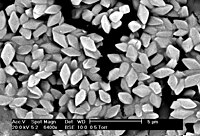
Photo from wikipedia
Discovering new antifungal agents is difficult, since, unlike bacteria, mammalian and fungal cells are both eukaryotes. An efficient strategy is to consider new antimicrobial proteins that have variety of action… Click to show full abstract
Discovering new antifungal agents is difficult, since, unlike bacteria, mammalian and fungal cells are both eukaryotes. An efficient strategy is to consider new antimicrobial proteins that have variety of action mechanisms. In this study, a cDNA encoding Bacillus thuringiensis Vip3Aa protein, a vegetative insecticidal protein, was obtained at the vegetative growth stage; its antifungal activity and mechanism were evaluated using a bacterially expressed recombinant Vip3Aa protein. The Vip3Aa protein demonstrated various concentration- and time-dependent antifungal activities, with inhibitory concentrations against yeast and filamentous fungi ranging from 62.5 to 125 µg/mL and 250 to 500 µg/mL, respectively. The uptake of propidium iodide and cellular distributions of rhodamine-labeled Vip3Aa into fungal cells indicate that its growth inhibition mechanism involves its penetration within cells and subsequent intracellular damage. Furthermore, we discovered that the death of Candida albicans cells was caused by the induction of apoptosis via the generation of mitochondrial reactive oxygen species and binding to nucleic acids. The presence of significantly enlarged Vip3Aa-treated fungal cells indicates that this protein causes intracellular damage. Our findings suggest that Vip3Aa protein has potential applications in the development of natural antimicrobial agents.
Journal Title: Antibiotics
Year Published: 2021
Link to full text (if available)
Share on Social Media: Sign Up to like & get
recommendations!